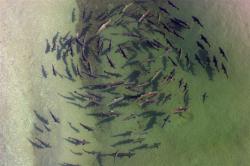 Millions of wild salmon and steelhead once returned to California's north and central coastal watersheds. Development over the last 100 years and the conversion of forestlands to urban and agricultural use led to the decline of these populations. From 1997 to 2000, California Coastal Chinook salmon, Northern California steelhead, and Central California Coast steelhead were listed under the federal Endangered Species Act as species threatened with extinction.
Millions of wild salmon and steelhead once returned to California's north and central coastal watersheds. Development over the last 100 years and the conversion of forestlands to urban and agricultural use led to the decline of these populations. From 1997 to 2000, California Coastal Chinook salmon, Northern California steelhead, and Central California Coast steelhead were listed under the federal Endangered Species Act as species threatened with extinction.
NOAA Fisheries released its final plan to recover these species by addressing the threats they face and restoring the ecosystem on which they depend. The recovery plan strategically targets restoration efforts to the needs of salmon and steelhead throughout each of their life stages, from their time as juveniles in freshwater habitat, through their maturation in the ocean, and their return to streams to spawn. Using this framework, the plan seeks to improve estuarine and riparian habitat conditions, restore floodplains and stream channels, enhance stream flows and improve fish passage across 8 million acres of California's north and central coast.
With science at its foundation, the plan provides for the biological needs of fish. A technical team of scientists, led by NOAA's Southwest Fisheries Science Center, developed criteria that will ensure the species persists over the long-term. The criteria address such attributes as population size and reproductive success rates, as well as sufficient geographic distribution and genetic diversity. The idea is to target on-the-ground actions to the needs of fish throughout their life cycle to restore robust populations across the landscape.
Many stakeholders, organizations and agencies commented on the draft recovery plan, and NOAA Fisheries took those comments into account to fine-tune several sections including recovery actions and criteria. The plan notes that continued public engagement and partnerships will be essential in the recovery of the north and central coast's salmon and steelhead runs.
Fully restoring the region's salmon runs will be challenging, but salmon and steelhead recovery will provide significant economic, social, and ecological benefits. California commercial and recreational salmon fisheries, for instance, are estimated to generate $118 to $279 million in income annually and provide roughly 2,000 to 3,000 jobs. A revived sport and commercial fishery would support substantial economic gains and job creation across the species' entire range, most notably in the state's river and coastal communities.
In addition, many of the actions identified in the plan will improve the natural processes of the watersheds. Not only do these actions benefit native plants and animals, but they also improve surface and groundwater supplies, reduce the cost of streambank stabilization or flood control activities, and limit the frequency of high severity fires.
Partnerships and collective action are the key to achieving recovery. Recovery plans are voluntary, and their success depends on federal agencies, resource managers, local governments, interested citizens, and private landowners coming together to implement the actions identified in the plan.
VIEW the recovery plan and associated materials.
GET INVOLVED in salmon recovery on the California Coast.
Copyright © 2013-2025 WesternBass.com ®


 Advertising
Advertising